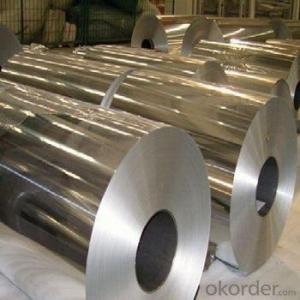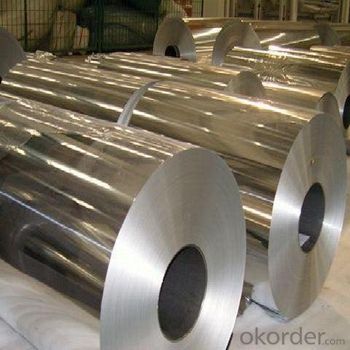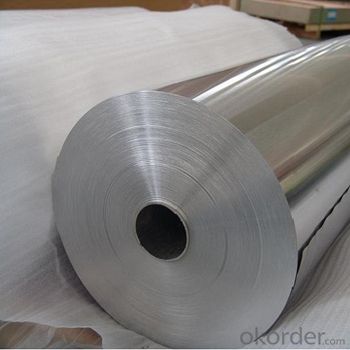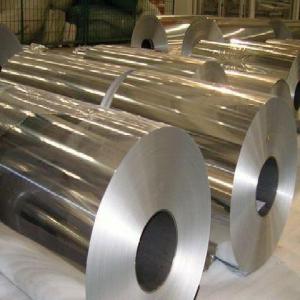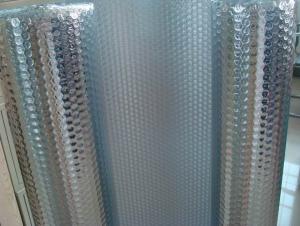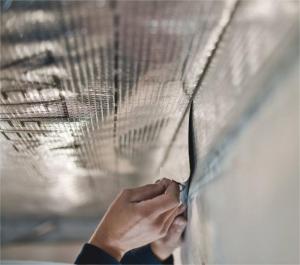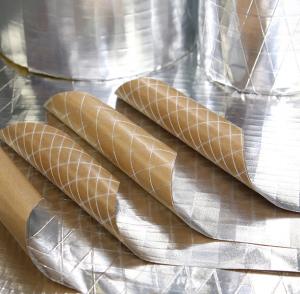Aluminum Foil Facing Reflexitive Bubble Foil Film Lamination Production
- Loading Port:
- Shanghai
- Payment Terms:
- TT OR LC
- Min Order Qty:
- 1212 tex
- Supply Capability:
- 213432 tex/month
OKorder Service Pledge
OKorder Financial Service
You Might Also Like
Aluminum foil facing insulation for Roofing Insulation
1. Aluminum Foil Facing Description:
The production technologies and products performance of aluminum foil facing have been up to international advanced level. The aluminum foil facing products are mainly used for HVAC system, refrigerators, building thermal aluminum foil facing insulation and laminated with glass wool and rock wool to increase the insulation function.
• Heat-sealing aluminum foil facing is used for duct wrap without applying extra adhesive and suitable for online lamination of glass wool and rock wool.
• The PSK aluminum foil facing, whose structure is white polypropylene/ fiberglass scrim/ kraft is mainly used for metal building insulation and suitable for the insulation of ware-house, factory, supermarket, office and so on.
2.Main Features of the Aluminum foil facing:
• Light weight
• High manufacturing accuracy
• High strength
• Small inertia resistance
• Strong heat dissipation ability
• Good visual effect
• High reflective insulation
• Heat resistant, water proof, stable at high temperature;
• environmentally friendly,no smell and not-toxic;
• Smooth and clear surface;
3.Aluminum Foil Facing Images

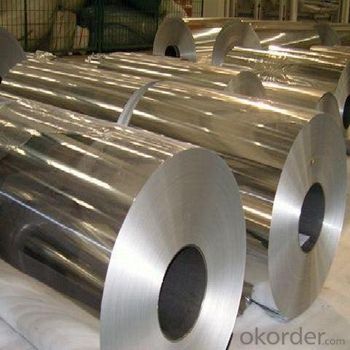
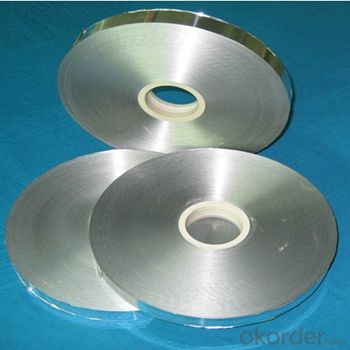

4.Aluminum Foil Facing Specification
TYPICAL PHYSICAL PROPERTIES:
Basic weight | gsm | 120 | ASTM D646 |
Tensile strength: M. D. X. D. | N/25mm | 140 75 | ASTM D828 |
Burst strength | N | 43 | ASTM D774 |
Reflectivity of foil surface | % | 95 | ---------- |
Temp. Resistance | -29°C 66°C | No Delamination No Delamination | ASTM C1263 |
Water vapor permeance | ng/N.s | 1.15 | ASTM E-96 |
Basic weight | gsm | 120 | ASTM D646 |
Tensile strength: M. D. X. D. | N/25mm | 140 75 | ASTM D828 |
Width: 1.0m, 1.2m, 1.25 m, 1.30, 1.37m
Length: 200m, 500m, 1000m, 2500m, 2750m, 3300m
Core I.D.: 3"(76mm ±1), 72mm ±1
Based on order, special sizes are also available.
5.FAQ
We have organized several common questions for our clients,may help you sincerely:
1. How about your company?
A world class manufacturer & supplier of aluminum foil facing and is one of the large-scale professional investment aluminum foil facing bases in China. Annually more than 1000 containers of aluminum foil facing are exported to markets in Europe, America and Japan.
What is the storage condition?
1,The products should be stored at room temperature and kept from wet and heat source.
2, It is essential, as with all pressure-sensitive tapes, that the surface to which the tape is applied must be clean, dry, and free of grease and oil.
3, The user should take test and do trial-application on the above products before coming into application so as to witness and ensure suitability for user’s special purpose and technique.
3. How to guarantee the quality of the products?
We have established the international advanced quality management system,every link from raw material to final product we have strict quality test;We resolutely put an end to unqualified products flowing into the market. At the same time, we will provide necessary follow-up service assurance.
4. How long can we receive the product after purchase?
In the purchase of product within four working days, we will arrange the factory delivery as soon as possible. The specific time of receiving is related to the state and position of customers. Commonly 7 to 10 working days can be served.
- Q: What precautions should be taken when handling hot food using aluminum foil as a cooking tool?
- <p>When handling hot food using aluminum foil, first ensure the foil is thick enough to withstand high temperatures without puncturing. Always use heat-resistant gloves or a thick cloth to avoid burns. Do not wrap food directly in aluminum foil if it's very hot, as this can cause the foil to tear or the food to stick. Allow the food to cool slightly before wrapping. When removing the foil from the heat source, use tongs or a spatula to avoid direct contact with the hot foil. Be cautious of steam when opening the foil, as it can be very hot.</p>
- Q: This question asks for the most suitable materials to be used in conjunction with aluminum foil facing.
- <p>The best materials to use with aluminum foil facing are those that are compatible with its properties. For insulation, materials like fiberglass or polyethylene foam are ideal due to their thermal resistance. For construction, materials such as plywood or drywall can be used as a backing, as they provide a sturdy base. When it comes to sealing, materials like butyl rubber or silicone are effective because they adhere well to aluminum foil and create a watertight seal. It's crucial to select materials that won't react chemically with aluminum and can withstand the environmental conditions in which the foil facing will be used.</p>
- Q: This question asks for signs or methods to identify if the aluminum foil facing of a product, such as insulation or a jacket, is damaged or defective.
- <p>To determine if your aluminum foil facing is damaged or defective, look for visible signs such as tears, punctures, or holes. Check for any discoloration or rust, which could indicate corrosion. The foil should be smooth and uniform; any irregularities or bubbling might suggest a defect. Additionally, test the integrity by gently pulling or pressing the foil鈥攊f it easily tears or crumples, it may be compromised. For insulation, a damaged foil facing can lead to reduced effectiveness in heat or cold retention, so also consider the performance of the item.</p>
- Q: This question asks for methods to clean aluminum foil after it has been used for cooking and has old food stuck to it.
- <p>To remove old food from aluminum foil facing after cooking, start by letting the foil cool down to avoid burns. Then, use a plastic scraper or the edge of a credit card to gently scrape off the food particles. For stubborn residue, you can soak the foil in warm, soapy water for a few minutes before scrubbing with a soft sponge or cloth. Avoid using metal scrubbers as they can scratch the foil. After cleaning, rinse thoroughly and dry before storing or reusing.</p>
- Q: What are the materials and elements that make up the aluminum foil facing?
- <p>Aluminum foil facing is primarily composed of aluminum, which is a lightweight, malleable, and ductile metal with the symbol Al and atomic number 13. It is commonly used in construction, packaging, and cooking due to its excellent thermal and electrical conductivity, as well as its resistance to corrosion. The aluminum used for foil is typically of high purity, but it may also contain trace amounts of other elements to enhance certain properties, such as copper to improve strength or magnesium to increase resistance to corrosion. The facing can also have a protective layer or coating to prevent oxidation or to enhance its performance in specific applications.</p>
- Q: Is it possible to enhance the flavor of food by using aluminum foil facing?
- <p>Yes, using aluminum foil facing can help make food more flavorful. It can seal in moisture and steam, which helps to keep the food juicy and tender. The foil also allows for even heat distribution, which can enhance the cooking process and the development of flavors. However, it's important to note that aluminum foil should not be used with acidic foods as it can react and potentially leach into the food. Additionally, for certain dishes, direct contact with the heat source can be necessary for achieving a desired texture or flavor, so the use of foil should be considered based on the specific recipe and cooking method.</p>
- Q: Is it safe to use the same piece of aluminum foil repeatedly before disposal?
- <p>Reusing aluminum foil is generally not recommended due to hygiene and food safety concerns. Each time you use foil, it can pick up bacteria from food and surfaces, which can multiply with subsequent uses. Additionally, the foil can tear or become thin, potentially allowing harmful substances to leach into your food. For safety, it's best to use a fresh piece of aluminum foil for each use.</p>
- Q: Explain the distinct characteristics of aluminum foil facing compared to other metal facings.
- <p>Aluminum foil facing is a type of metal facing material that is made from thin sheets of aluminum, known for its light weight, high reflectivity, and excellent heat resistance. It is commonly used in construction for insulation and moisture protection. In contrast, other types of metal facings, such as steel or copper, may offer different properties. Steel facings are often stronger and more durable but can be heavier and less resistant to corrosion without protective coatings. Copper facings are known for their natural resistance to corrosion and can be used in applications requiring antimicrobial properties or high thermal and electrical conductivity. Each type of metal facing has its unique advantages and is chosen based on specific application needs.</p>
- Q: Is it possible to use aluminum foil with a shiny side facing up as a liner for a baking pan?
- <p>Yes, you can use aluminum foil facing as a baking pan liner. The shiny side of the aluminum foil is non-stick and can be used to line baking pans, making it easier to remove baked goods without sticking. Ensure the foil is heavy-duty to withstand high temperatures and prevent tearing. However, avoid using it for direct contact with acidic or alkaline foods, as the foil may react with them. Always follow the manufacturer's guidelines for safe use.</p>
- Q: Is it possible to recycle aluminum foil with a plastic facing in various countries?
- <p>Recycling practices for aluminum foil with plastic facing vary by country. In some regions, such as parts of Europe and North America, recycling facilities may accept and separate aluminum foil from its plastic lining. However, in other countries, this type of material might not be recyclable due to the difficulty in separating the aluminum from the plastic. It's essential to check local recycling guidelines, as the ability to recycle aluminum foil with plastic facing largely depends on the infrastructure and capabilities of local recycling centers.</p>
Send your message to us
Aluminum Foil Facing Reflexitive Bubble Foil Film Lamination Production
- Loading Port:
- Shanghai
- Payment Terms:
- TT OR LC
- Min Order Qty:
- 1212 tex
- Supply Capability:
- 213432 tex/month
OKorder Service Pledge
OKorder Financial Service
Similar products
Hot products
Hot Searches
Related keywords

